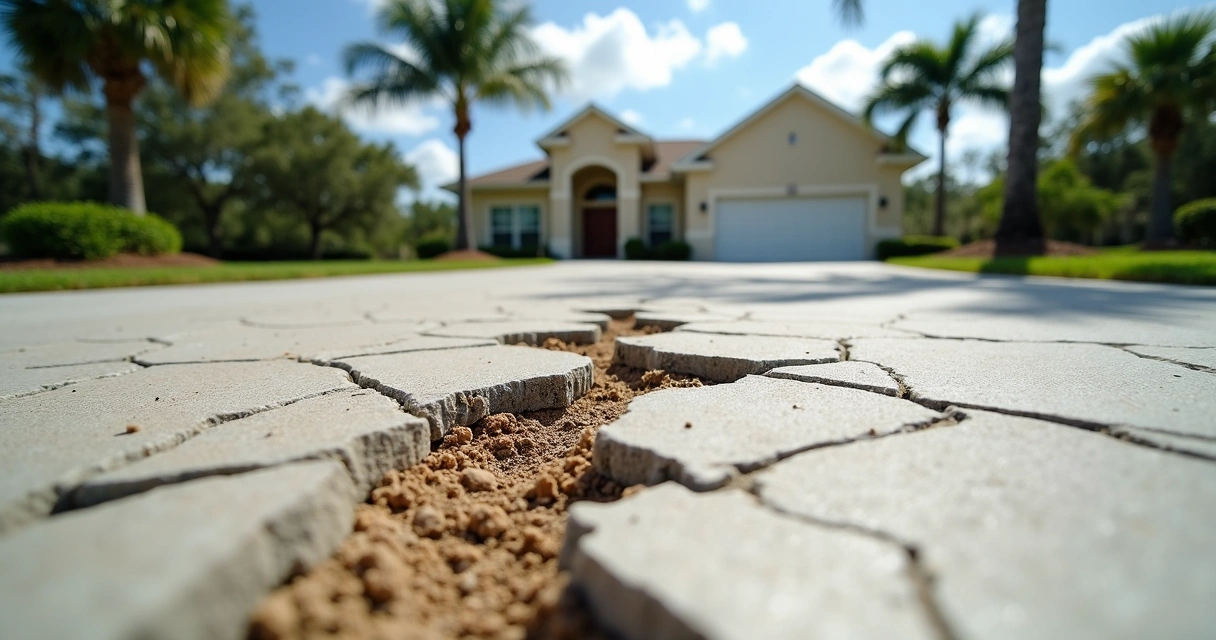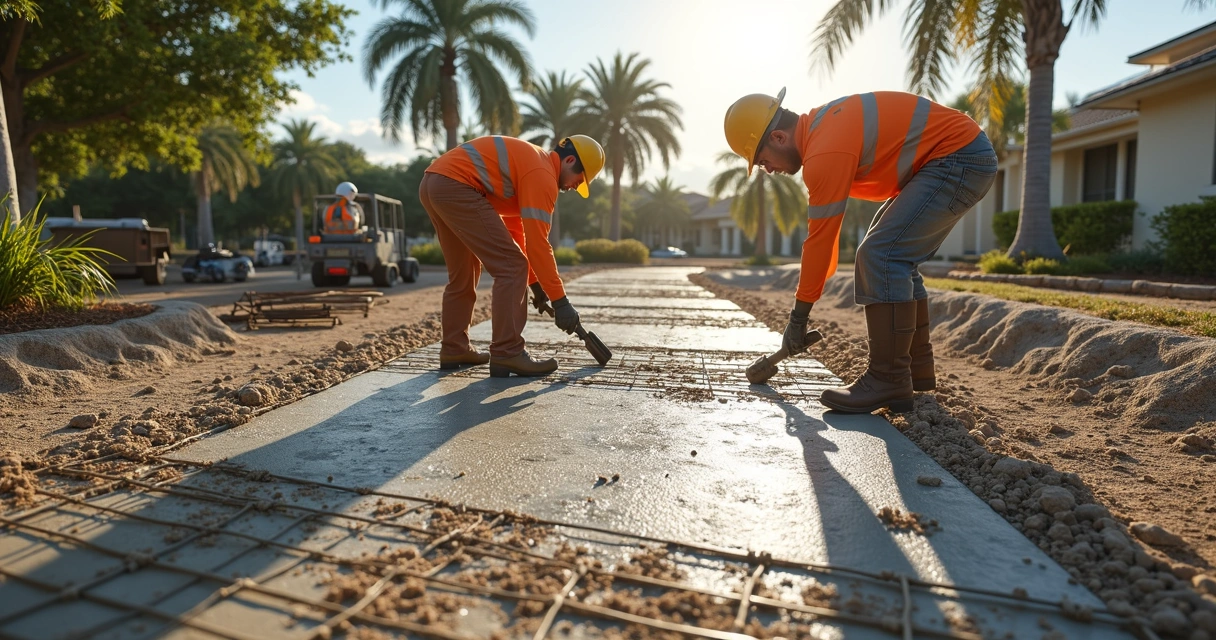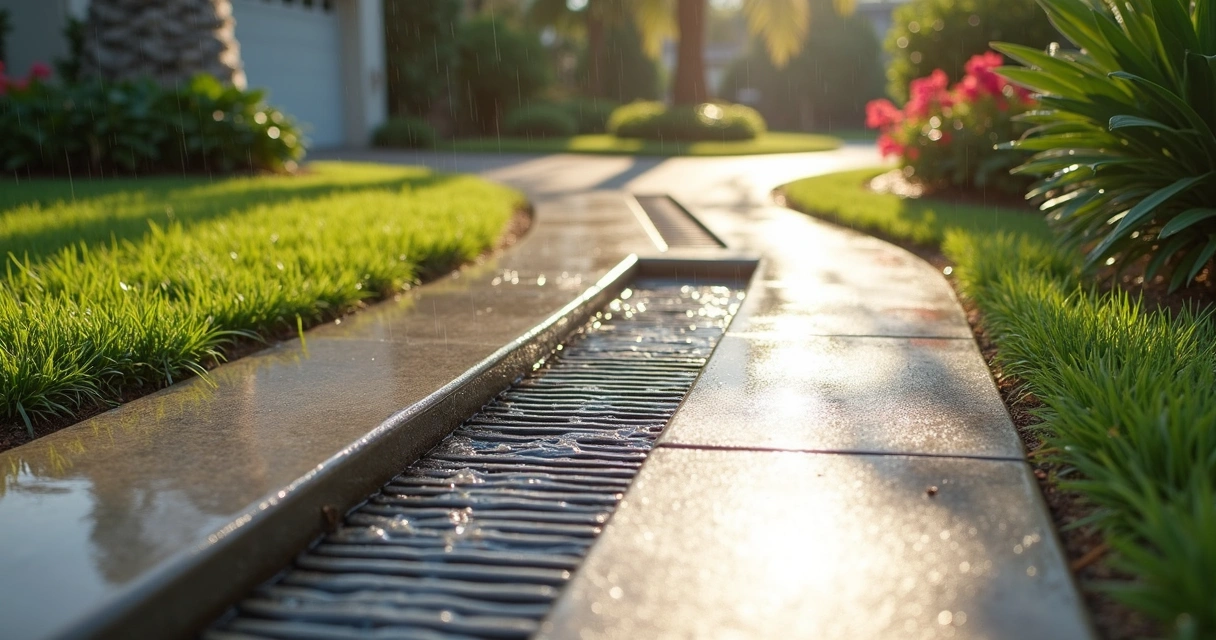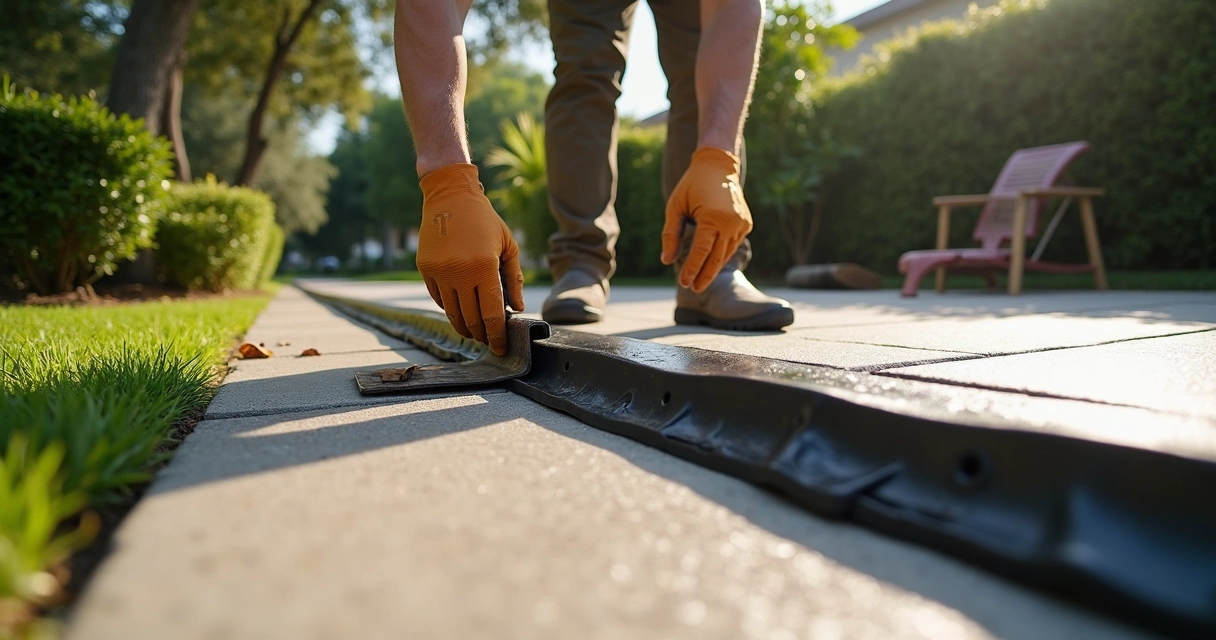Concrete cracks in Florida aren’t just a nuisance—they’re common. Sun, rain, tree roots, sandy soils, and even the salty breeze all take their toll. But does that mean you can’t have a beautiful, long-lasting concrete patio or driveway? Not at all.
GCM Best Services works across Central Florida, building and restoring patios and driveways, so we’ve seen what works and what doesn’t. It’s not only about pouring concrete; it’s about understanding the climate, the ground beneath, and the best practices for durability. And believe it or not, there’s a bit of an art to it.
Small cracks today can grow into big cracks tomorrow.
Here’s a complete guide to keeping them from starting, and what to do if they do.
Florida’s unique challenges: why cracks form so easily
Concrete in Florida has special enemies. Sure, concrete cracks everywhere, but the Sunshine State brings extra baggage.
- Expansive, sandy soils. Florida’s ground shifts, sinks, and swells as rain comes and goes. This can undermine flatwork and let concrete bend just enough to crack.
- Heavy rains and high water table. After a rainy week, the ground swells and settles as water moves through sandy subsoils.
- Sun and heat. Daily temperature swings (not just summer heat) cause concrete to expand and contract, adding stress over time.
- Tree roots. Live oaks, palms, and ficus can push up slab edges. Sometimes you won’t see it coming—then suddenly, a root pops up and you’ve got a raised, cracked corner.
- Salty air and humidity. Near the coasts, even the air adds invisible enemies, especially if there’s steel rebar inside the concrete, hastening corrosion and weakness (explored in University of South Florida research on cathodic prevention).
Sound familiar? You’re not alone—Florida’s environmental stresses are well-documented and explain why standard approaches from other regions often fall short with concrete here.
 The basics of concrete cracking: what’s normal, what’s not
The basics of concrete cracking: what’s normal, what’s not
Concrete is durable, but it’s not invincible. Some hairline cracks are almost unavoidable. What matters is size, pattern, and movement.
- Hairline cracks: Fine and shallow, these are largely cosmetic. Often due to minor shrinkage as concrete cures.
- Wide or jagged cracks: These signal movement under or within the slab. Maybe soil is eroding or tree roots are lifting a corner.
- Displaced cracks: Where one side is higher than the other. This usually means something underneath is changing, or a major root is pushing.
- Spider-web cracks: A network of superfine cracks is usually from rapid drying or poor finishing.
Not every crack means disaster, but every crack tells a story.
Distinguishing between “normal” shrinkage and warning signs helps you pick the right response. Even the EPA’s study on Florida homes found that cracks are often related to inadequate site prep, poor drainage, and thin slabs (according to this EPA report).
Prevention begins before the pour: site prep and sub-base
Once concrete is poured, the die is mostly cast. But what happens underneath is the determining factor for longevity. The team at GCM Best Services sees it firsthand: good prep lasts, shortcuts fail.
- Soil compaction: A six to eight-inch compacted base is best for patios, driveways, and walkways. Loose or uneven subgrade leads to settling and bending, which cracks concrete.
- Drainage design: The slab needs a slight slope away from the house to prevent water pooling. French drains, swales, or underground pipes may help in low spots.
- Vapor barrier: A thick plastic sheet below the slab helps block soil moisture, especially where humidity is high or there’s a shallow water table.
- Edge restraints and forms: Straight, strong forms keep the edges tight, avoiding weak spots where cracks start.
It might sound like overkill, but every dollar on proper site prep can save hundreds in repairs. The EPA’s study emphasizes just how much proper sub-base standards reduce cracks and slab movement.
 Concrete mix matters: right materials for Florida weather
Concrete mix matters: right materials for Florida weather
You might assume “concrete is concrete.” But what goes in makes a world of difference—especially here.
- Strength: For Florida patios and driveways, a 3,000 – 4,000 PSI mix delivers lasting strength. Anything less? Too weak for cars and bikes, and vulnerable to cracking in our climate.
- Water-to-cement ratio: Lower is better—too much water equals a weaker slab that shrinks as it dries, inviting cracks.
- Admixtures: Shrinkage-reducing agents, fiber reinforcements, and plasticizers help concrete resist internal forces and move without breaking apart.
- Aggregate gradation: Mixing large and small stones (optimum gradation) makes concrete stronger and less prone to shrinkage cracks.
A 2020 study by the University of Florida tested how shrinkage-reducing admixtures and optimized aggregate gradation cut down on cracking. They found that using OAG (optimized aggregate gradation) in internally cured concrete mixes extended pavement life and limited cracks, with especially good results for mixes with lots of cement and low water.
Working with a team that understands these details, like GCM Best Services, can spare you from the mistakes of off-the-shelf concrete recipes.
Reinforcement: mesh, rebar, and fibers
Steel mesh and rebar aren’t just for big buildings—they’re key for patios and driveways. They help the slab flex as the ground moves, and will hold cracks tight if they do occur. Think of it as a protective skeleton.
- Rebar: Run through thicker driveways or large patios. Helps prevent wide, separating cracks.
- Wire mesh: For normal-size slabs, mesh boosts surface crack resistance.
- Fiber additives: Small polymer fibers blended in during mixing dramatically reduce shrinkage cracks by distributing stress more evenly.
Concrete is strong in compression, but needs help in tension.
For Florida, where the soil is always shifting, reinforcement is your best insurance.
Control joints: the guided crack solution
Nobody wants a big unsightly crack running through the middle of a new driveway. Control joints are the answer.
These purposeful weak spots, placed at set intervals, allow the concrete to crack where it’s least obvious and most manageable.
- How often? Joints should be spaced about equal to 2–3 times the slab thickness in feet. For a 4-inch slab, a joint every 8–12 feet is standard.
- How deep? About one-quarter the slab depth—that’s deep enough to control the crack direction.
- When to cut? The best time is within 12–24 hours of pouring, before shrinkage pulls the surface apart randomly.
If you skip or misplace control joints, you’re at the mercy of nature.
Proper finishing and curing: patience pays off
It’s tempting to rush finishing (especially when rain is on the radar), but skipping steps causes weak spots and rapid surface cracking. Even if it all looks good at first, you may get a surprise after a few sun cycles.
- Broom or exposed finishes: These non-slip textures improve grip and slow water seepage, but must be applied with care to avoid tearing the surface.
- Slow curing: Cover the surface with plastic or keep lightly wet for at least a week. Rapid drying forms “crazing” (web-like cracks) and weak edges.
- Contain runoff: Florida rains turn fresh concrete into a mess. Direct spouts and add straw barriers so water can’t pool or wash out cement paste.
Good concrete, like a good meal, should never be rushed.
Another tip from GCM Best Services: night or early morning pours help avoid Florida’s high midday heat, keeping the surface moist longer. It takes extra effort and good planning, but it’s worth it.
Drainage solutions: keeping water away from the slab
Water is perhaps concrete’s biggest enemy. Not just hurricanes—a simple weekly downpour or poorly aimed sprinkler matters too.
- Sloped slabs: Even a barely-there slope (1–2%) sends rain away from the house and slab edges. Never let water pool in low spots—standing water soaks underneath and weakens support.
- Gutters and downspouts: Direct roof runoff well beyond the edge of the driveway or patio. Splash blocks help, but underground drains are better if you have persistent soggy areas.
- Pervious concrete: For driveways or patios in flood-prone areas, consider pervious pavement. University of Central Florida research found that proper design and routine cleaning help keep pervious concrete systems draining well for years (see this University of Central Florida study).
- Landscape grading: Beds and lawns should gently slope away from hard surfaces to avoid backflow or pooling water.
A beautiful patio or driveway won’t last if water erodes its foundation. Fix drainage issues early, or plan for persistent repairs.
 Surface treatments and sealing: the protective shield
Surface treatments and sealing: the protective shield
Florida’s wet-dry cycles, extreme sun, and humidity quickly break down exposed concrete surfaces. Sealing acts as a sacrificial layer—fends off moisture, chemicals, and stains, and helps blocks small cracks from growing.
- Pene trating sealers: Soak into the surface to repel water without changing color or feel. Good for brushed or stamped finishes.
- Film-forming sealers: Leave a visible layer, boosting shine and stain resistance. Useful for colored or decorative concrete.
- Resealing: Most patios and driveways need reapplication every 2–3 years—sometimes sooner if subjected to heavy use or direct sun.
- Epoxy or polyaspartic coatings: For garages or surfaces facing chemical spills, these two-part systems are highly resistant and fast to cure (another specialty of GCM Best Services).
A sealed surface can resist Florida’s harshest storms and baking sun longer, making routine care and sealing a smart investment.
Landscaping, roots, and beyond: extra precautions
Even the best concrete can’t beat a giant oak root head-on. Still, a few strategies can buy you years without cracks:
- Root barriers: Physical plastic or metal panels sunk vertically help deter roots from getting under new slabs.
- Setback distance: When possible, keep big trees at least 10–15 feet away from patios and driveways. If you must build close, reinforce the slab and keep control joints closer together.
- Regular pruning: Roots follow water. Keep irrigation away from slab edges, and cut back feeders before they get strong enough to push concrete upward.
It may seem a little strict, but Florida trees grow rapidly, and their roots can move surprising distances. GCM Best Services often works closely with customers to balance beautiful landscaping with a practical need for space from hard surfaces.
 Regular care and fixing minor cracks: keep things under control
Regular care and fixing minor cracks: keep things under control
Even with the smartest design, tiny cracks might still show up. The key is catching them early and responding quickly:
- Inspect regularly. Every few months, scan your slab for new cracks, rough spots, or loose gravel.
- Clean cracks out. Use a stiff brush or compressed air. Remove soil, moss, or debris that can hold moisture and make things worse.
- Use flexible fillers. For tiny (hairline) cracks, use a concrete-compatible caulk or elastomeric filler. They stretch and move instead of just popping out the next hot day.
- Watch for displacement. If one side of the crack is higher, monitor for root growth or settling. Larger movement means professional help is needed.
- Rinse off chemicals. Fertilizers, de-icers (not so much in Florida but in rare cases), oils, and pool chemicals will eat away at unprotected concrete.
Small routine checks catch big trouble before it spreads. Think of it as ‘health care’ for your patio or driveway.
When replacement is needed
Maybe it’s patch after patch, or the slab looks more like a puzzle than a patio. Sometimes, the right answer is to start fresh. This is true if:
- Cracks keep reopening after repair.
- Multiple displaced or sunken sections—lifting one fix causes another issue.
- Deterioration along most of the surface, indicating underlying soil trouble.
GCM Best Services approaches these situations with on-site assessments, including soil checks, drainage evaluation, and discussions about better reinforcement or improved slabs. Sometimes, partial replacement is possible, especially where good control joints already exist.
Cutting-edge approaches: new research and methods
Science keeps moving forward, changing how we think about concrete. For Florida, some of the most relevant advances include:
- Internally cured concrete: The University of Florida’s 2020 research on internally cured concrete with optimized aggregate mixes shows real promise; longer service life and fewer cracks, especially for modern patios and driveways (see this UF study).
- Cathodic prevention for rebar: If you’re close to saltwater, new techniques in cathodic protection can delay the start of rebar corrosion—extending the life of reinforced slabs (read about this USF thesis).
- Optimized pervious pavements: The University of Central Florida’s research underlines that well-designed, well-maintained pervious concrete is practical for driving and walking surfaces, if you keep up with cleaning and drainage (learn more from UCF’s research).
Not every advance is ready for every home yet, but knowing what’s coming helps homeowners in Florida make better choices for new projects.
What GCM Best Services does differently
You can take every step on this list as a homeowner, or you can work with contractors who already treat these as their standard. GCM Best Services manages every project with Florida conditions in mind:
- Compacted sub-bases using the right materials for your local soil—it matters street by street.
- Experienced planning for drainage, integrating drains and slopes right from the start.
- Custom concrete mixes, often with admixtures and fibers, built to match your slab use and exposure.
- Reinforcement and joint placement planned for both durability and looks.
- Full permit management and clear communication, including photos of every stage and a written warranty for your peace of mind.
Whether it’s a classic broom-finished driveway, a decorative stamped patio, or a seamless garage coating, GCM Best Services brings a personal approach and a serious respect for Central Florida’s concrete challenges.
A patio or driveway that lasts is no accident—it’s the result of smart decisions, every step of the way.
Bringing it all together: your next steps
Living in Florida means dealing with heat, storms, and all sorts of odd challenges. But you don’t have to settle for cracked, tired concrete. Thoughtful planning, honest assessment, and a bit of patience can give you a strong, beautiful driveway or patio for years.
Looking for a fresh start, or need another eye on ongoing issues? Reach out for a no-obligation site visit from GCM Best Services. Our team is ready to guide you, step by step—from free estimates and design choices to finished slabs backed by written warranty. Don’t wait for small cracks to become big headaches. Get in touch with GCM Best Services today and make your Florida concrete dreams real.
Frequently asked questions
What causes cracks in Florida concrete?
Cracks in Florida concrete often come from several combined factors: shifting sandy soils, yearly rain and drought cycles, rooting trees, high summer temperatures, and sometimes poor site preparation. Environmental changes cause ground movement under slabs, and expansion or shrinkage in the concrete adds stress. Research from the EPA shows that improper compaction and drainage are also frequent culprits.
How often should I seal my patio?
It depends on the type of sealer, sun exposure, and use, but most Florida patios and driveways benefit from sealing every two to three years. High-traffic or fully exposed surfaces in direct sunlight may need it yearly. Always clean the concrete thoroughly before resealing.
What is the best crack prevention method?
There isn’t a single “best” method, but layering good practices works. Proper site prep with well-compacted sub-base, quality concrete with the right water ratio and admixtures, steel or fiber reinforcement, well-placed control joints, and a good drainage plan all combine to prevent most cracks. Following the best construction standards recommended in studies like this University of Florida report gives the best long-term results.
When should I repair small cracks?
As soon as you notice them. Early caulking or sealing prevents water from getting in, which can make cracks grow or allow the underlying soil to shift. Delayed repairs often mean more expensive work later on.
How much does concrete repair cost?
It varies. Small crack filling or patching with flexible caulk may run as little as $50–$150 for DIY. Professional repairs for larger cracks or sunken sections can range from a few hundred to several thousand dollars, depending on the size and cause. Replacing large areas, if needed, is more expensive—but many problems can be stopped early with timely maintenance.